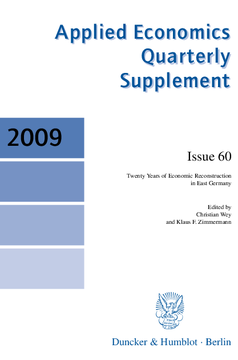Twenty Years of Economic Reconstruction in East Germany

BOOK
Cite BOOK
Style
Format
Twenty Years of Economic Reconstruction in East Germany
Editors: Wey, Christian | Zimmermann, Klaus F.
Applied Economics Quarterly. Supplements, Vol. 60
(2009)
Additional Information
Book Details
Pricing
Abstract
This year marks the 20th anniversary of German reunification. The events of autumn 1989 revealed that the GDR was not just politically but also economically bankrupt. Given the large-scale emigration to the West after the fall of the Wall, the D-Mark was introduced quickly, despite widespread rejection of this measure by the leading economist of the time. Rapid wage increases intensified the pressure on businesses, and the adjustment shock made it necessary to rebuild the foundations of the economy at a rapid pace and an extremely high cost. With the creation of the economic and currency union, a dynamic process of growth and development was launched in many areas of society.Twenty years later, the questions arise: Where do we stand today, what implications can be derived for the future, and what remains to be done in the policy realm? This AEQ Supplement addresses the following issues:- Structural convergence and regional development: Should policy makers really attempt to counteract convergence? How far is East Germany currently lagging behind? What strategic decisions do policy makers need to make?- Old-age poverty: Is there an increasing risk of old-age poverty in East Germany? What are the results of societal aging in East Germany?- Returns to education for full-time employees: The East has caught up- Dramatic demographic changes in Thuringia: Will Thuringia face a shortage of skilled labor up to 2015?
Table of Contents
| Section Title | Page | Action | Price |
|---|---|---|---|
| Editorial | 5 | ||
| Contents | 7 | ||
| Markus Demary / Klaus-Heiner Röhl: Twenty Years after the Fall of the Berlin Wall: Structural Convergence in a Slow-Growth Environment | 9 | ||
| Abstract | 9 | ||
| 1. Introduction | 9 | ||
| 2. The Convergence towards West Germany Has Failed So Far – Or Has it Really? | 10 | ||
| 2.1 The State of Convergence | 10 | ||
| 2.2 Adjustment Towards the West German Economic Structure | 13 | ||
| 2.3 Regional Development in Manufacturing | 14 | ||
| 2.4 Shortcomings in High-Tech Industries | 16 | ||
| 2.5 The Role of New Industrial Clusters | 16 | ||
| 3. Regional Investment Incentives in East Germany – Does the Joint Task Work? | 18 | ||
| 3.1 A Panel Data Regression Model for East German Regions | 19 | ||
| 3.2 Empirical Results for Regions | 22 | ||
| 3.3 Industry-Specific Empirical Results | 25 | ||
| 4. Conclusions | 26 | ||
| References | 27 | ||
| Klaus-Werner Schatz: Twenty Years after the Fall of the Berlin Wall: Structural Convergence in a Slow-Growth Environment. Comment | 29 | ||
| 1. Macroeconomic East-West Convergence | 29 | ||
| 2. East Germany: Catching up by the Migration of its Population? | 29 | ||
| 3. Structural Convergence | 30 | ||
| 4. Implications | 32 | ||
| References | 33 | ||
| Stefan Krenz / Wolfgang Nagl / Joachim Ragnitz: Is There a Growing Risk of Old-Age Poverty in East Germany? | 35 | ||
| Abstract | 35 | ||
| 1. Introduction | 35 | ||
| 2. The German Pension System | 36 | ||
| 3. Demographic Setup in East Germany | 38 | ||
| 4. Data and Methodology | 39 | ||
| 5. Single-Person Households | 41 | ||
| 6. Two-Person Households | 45 | ||
| 7. Widows | 48 | ||
| 8. Conclusion | 49 | ||
| References | 50 | ||
| Jürgen Schupp: Is There a Growing Risk of Old-Age Poverty in East Germany? Comment | 51 | ||
| Herbert S. Buscher et al.: Will There Be a Shortage of Skilled Labor? An East German Perspective to 2015 | 55 | ||
| Abstract | 55 | ||
| 1. Introduction | 55 | ||
| 2. Forecast of Labor Demand and Supply in Thuringia | 57 | ||
| 3. The Perspective of Firms | 65 | ||
| 4. Policy Recommendations and Conclusions | 70 | ||
| References | 75 | ||
| Hilmar Schneider: Will There Be a Shortage of Skilled Labor? An East German Perspective to 2015. Comment | 77 | ||
| General Remarks | 77 | ||
| Remarks in Particular | 78 | ||
| Conclusion | 81 | ||
| References | 81 | ||
| Katie Lupo / Silke Anger: Returns to Human Capital in Germany Post-Unification | 83 | ||
| Abstract | 83 | ||
| 1. Introduction | 83 | ||
| 2. Literature Review | 84 | ||
| 3. Data | 85 | ||
| 4. Empirical Strategy | 87 | ||
| 5. Results | 88 | ||
| 5.1 Initial Transition Years | 88 | ||
| 5.2 Returns to Experience | 90 | ||
| 5.3 Returns to Education | 94 | ||
| 5.4 Migrants | 96 | ||
| 5.5 Returns to School Leaving Degrees | 98 | ||
| 6. Conclusion | 102 | ||
| References | 103 | ||
| Wolfgang Scheremet: Returns to Human Capital in Germany Post-Unification. Comment | 105 | ||
| Data | 106 | ||
| Results | 107 | ||
| Participants | 111 |
